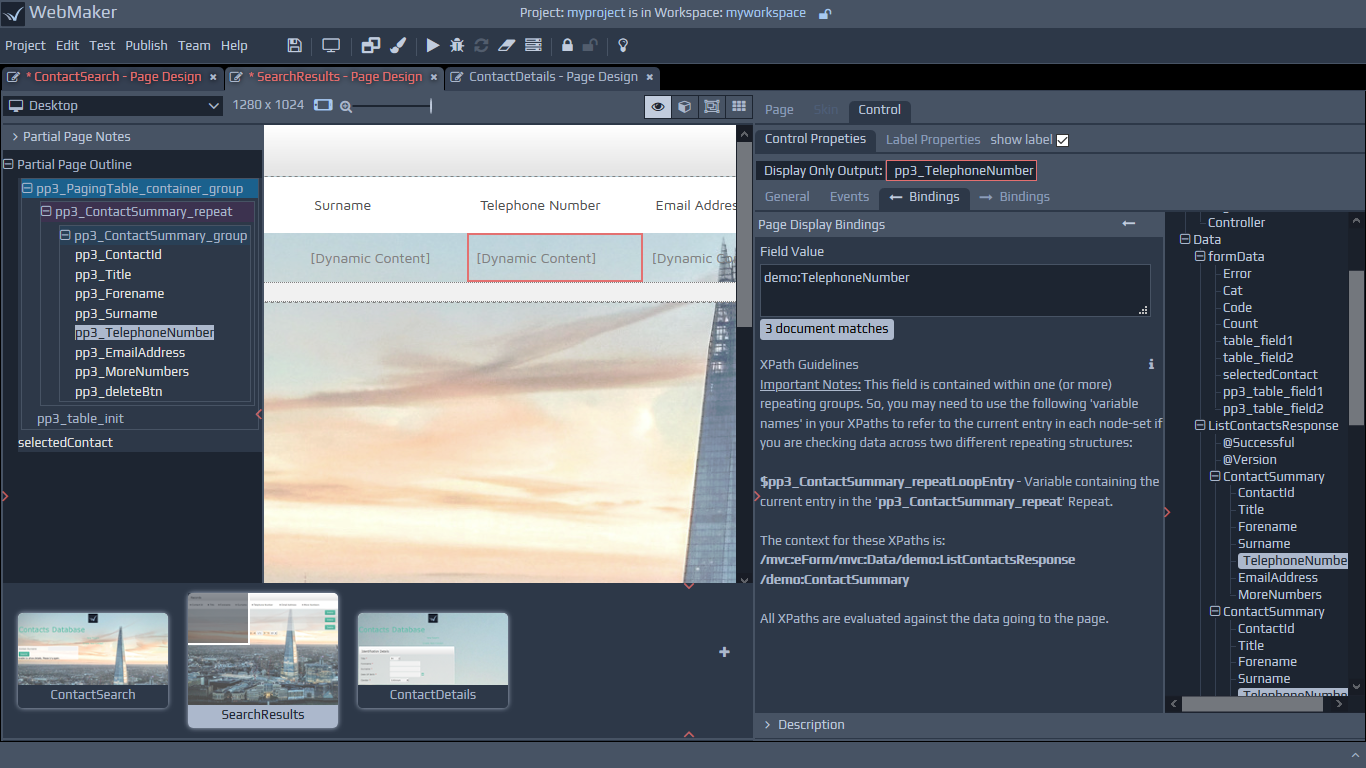 The Action Submission Bindings, within the second Bindings tab, contain a list of actions that can be activated from the Page. Each of these entries can be clicked to reveal the submission bindings and the associated XML document structure that will be used to submit data to the server.
The Action Submission Bindings, within the second Bindings tab, contain a list of actions that can be activated from the Page. Each of these entries can be clicked to reveal the submission bindings and the associated XML document structure that will be used to submit data to the server.
Binding Document Structures
When you create pages using the Page Designer, WebMaker automatically generates XML document structures, which are shown in the tree on the right hand side of each of the Bindings tabs. These XML document structures are created using best assumptions and they can be modified using the Edit Document link on the right hand panel. Depending on your Edit | Preferences menu option settings, this will either open the document within an editor in your browser or an external editor. Note: Please don't forget to use the Refresh link to reflect any changes to the binding documents.
The Page Display Bindings document is used at design time for previewing pages with sample data, contained within such documents. They are not used by the running application, but the data and document structures prepared by server controllers need to adhere to the same structure to ensure proper rendering of pages. The Action Submission document structures within the second Bindings tab, are used at runtime, to capture and submit information to the server. Many configuration options are available for fine-tuning and configuring the arrangement and behaviour of these binding documents, which will be discussed in more detail later in this section.
The following provides an overview of the decision making processes, used to generate the XML document structures for data binding:
Palette Controls - When palette controls are dropped on to the canvas, one or more elements using the control name or its derivative are created within the formData element. This is the default container for page fields when the Page Designer has been unable to establish a binding structure for a given element. The
/mvc:eForm/mvc:Controland
/mvc:eForm/mvc:Dataelements are the generic containers for WebMaker data and will be applied to all messages by default. This is to provide a standard wrapper that can be used during development. The
Controlblock is mainly used by WebMaker to control the application processing, and the
Datablock is for the application data. The
/mvc:eForm/mvc:Data/mvc:formDatais nested within the
Datablock. The same binding structure is generated for Page Display Bindings and Action Submission Bindings. This default structure for the Action Submission Bindings is used for all actions originating from pages, which do not have their own binding structures. Further detail is available later in this section. Data Sources - When Data Source elements are used during page design (W3C Schema, WSDL, SQL Database Schema, etc.) the structure of the data source is used to create the XML binding structures. WebMaker will attempt to detect if the fields originate from an editable data source. If the source is editable, WebMaker will use a wizard (Requires server controllers) to request additional mapping information between page actions and the target data sources, which will receive the data submitted by such actions at runtime via server controllers. For each action that is selected in this wizard, the structure for the data source, used to design the page, will be added to the submission binding document for that action. If an action is not selected (or if the data source is not deemed editable) then elements will be created within
formDataas normal. Submission data structures, derived from data sources, will be placed within the
/mvc:eForm/mvc:Dataelement. For web services, this will be the root element of data defined as the Request or Response message as appropriate e.g.
/mvc:eForm/mvc:Data/demo:ListContactsRequestor
/mvc:eForm/mvc:Data/demo:ListContactsResponse. For SQL Databases, it will be the name of the SQL table selected e.g.
/mvc:eForm/mvc:Data/accounts_tableWhen you work with these documents and XPaths, it is important to be aware of namespaces, which is detailed in later sections. Skin Data - Page Display Bindings for Skin Data is handled in the same manner as normal pages. An mvc:skinData fragment is used within mvc:Data to submit skin data for all submissions using a similar structure to mvc:formData. For Partial Pages, you will see a combined list of actions, which includes actions originating from the partial page and also its main parent container page. The XML message structure will be a composite of the data within the main page and the partial pages it contains.
Using XPath to match binding data
The binding information for each page consists of a number of XPaths. XPath is a simple, but powerful document inspection language to match elements inside XML document structures. XPath Guidelines under different areas within the Bindings tabs provide additional information. You can drag elements from the tree structure and drop them on the XPath fields to create XPaths. You can also manually enter XPaths.
A Guide to Useful XPath Queries (PDF) on the WebMaker Forum is a useful resource.
 Most of the bindings will be pre-populated for you. The main bindings that will not have been pre-populated are those for additional features that have been enabled, such as Conditional Styling or Visibility Details selected on the Properties tab. In these cases, a message stating
Most of the bindings will be pre-populated for you. The main bindings that will not have been pre-populated are those for additional features that have been enabled, such as Conditional Styling or Visibility Details selected on the Properties tab. In these cases, a message stating enter_xpath_herewill be displayed.